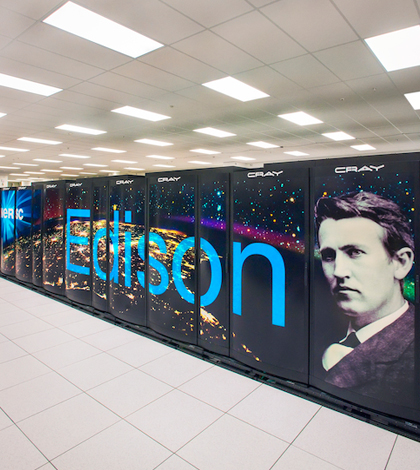Supercomputers usher in golden age of high-resolution climate models

Beyond the rabble-rousing spheres of conspiracy theorists and pundits, the scientific community has more or less agreed: the Earth is heating — fast. The remaining questions are centered around the impact that climate change will have on coming generations and the world they’ll inherent.
Sophisticated computer models give scientists glimpses into the Earth’s warmer future, revealing localized trends such as increased lightning strikes in the U.S. and poor crop performance in Africa. But the global implications of climate change are harder to pin down, and determining them requires heavy lifting from some seriously powerful computers.
Michael Wehner, senior scientist at Lawrence Berkeley National Laboratory, used supercomputers at Berkeley Lab’s National Energy Research Scientific Computing Center to run a high-resolution simulation of a global climate model. With more than 150,000 processing cores, the Cray XE6 supercomputer known as “Hopper” allowed Wehner to complete in three months what would have taken scientists years in the recent past.
“I’ve waited a long time to be able to do this kind of computation,” Wehner said. In fact, Wehner has been running climate simulations since the early 1990s.
Predicting future precipitation patterns and temperature levels are one thing, but Wehner has his sights set on bigger, badder weather, extreme storms such as hurricanes and tropical cyclones. Studying the dynamics of these storms in a hypothesized world requires high-fidelity models. Earlier global climate models made do with a 100-kilometer resolution — Wehner’s could work on a 25-kilometer scale, and “very well” at that. “The downside,” he said, “is that it’s much more computationally expensive.”
Lucky for Wehner, the computers at NERSC have the resources to pay up, and then some. Hopper, named for pioneering computer scientist and U.S. Navy Rear Admiral Grace Hopper, runs at a blinding 1.28 petaflops per second, which is to say it can perform 1.28 quadrillion calculations per second. As if that wasn’t fast enough, NERSC also houses Edison (as in Thomas Alva), a cluster supercomputer capable of more than 2 petaflops per second.

NERSC Cray XE6 Hopper supercomputer cluster. (Roy Kaltschmidt / Lawrence Berkeley National Laboratory)
Wehner is hoping to bring the runtime of his simulation down from three months — which he concedes is “kind of a long time to wait for a calculation” — to just one. But he also says that the future of global climate modeling has a lot more in store than that.
“This transformation that we have is big, but we’re not done, and I fully believe that high performance computing will continue to evolve at a rate that is going to help us further our modeling abilities,” Wehner said. “When we get to one- or two-kilometer scales from 25, we can actually address the major deficiencies in these models, and that’s clouds.”
Running simulations at that resolution will require machines with peak speeds around an exaflop, or 1,000 petaflops per second. As big of a technological leap as that might seem, Wehner believes such an advancement could be mere decades away — or sooner.
Some interesting hypotheses have arisen from the improved models, Wehner said. One, for instance, states that intense hurricanes will be more common in a warmer world. Another expands upon that idea, projecting that global hurricane occurrences will decrease, but those that do form will be overwhelmingly powerful with few weak storms in the mix. The only certainty is that even better models and faster computers will play a key role in climate science over the crucial decades to come.
“This technology has really enabled a new class of climate models,” Wehner said. “It’s a pretty exciting time, actually.”
Top image: NERSC Cray Edison supercomputer cluster. (Roy Kaltschmidt / Lawrence Berkeley National Laboratory)




0 comments